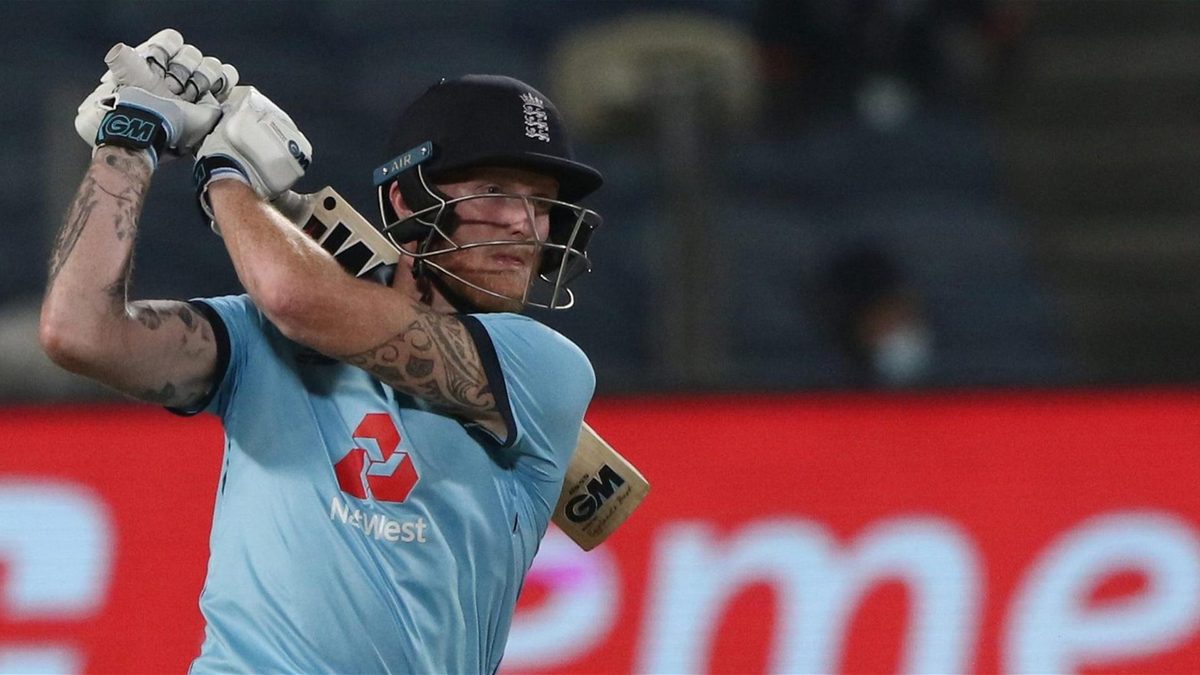
Ben Stokes smashed a 52-ball 99 at No.3 in the second India-England ODI, an innings to suggest he may be being wasted at No.6 in T20I cricket, writes Ben Gardner.
Subscribe to the Wisden Cricket YouTube channel for post-match awards, player interviews, analysis and much more.
After the first ODI, the general consensus was that England had missed Joe Root more than they thought they might. Up until the point that their first wicket fell, the game had followed a script by now thrillingly familiar to a legion of England fans. The bowlers concede a total that, until six or so years ago, would have been far beyond their batsmen. Then Jonny Bairstow and Jason Roy get off to a flier, and England nonchalantly cruise home.
Root’s innings in these ‘whatever you do, we can do bigger’ epics often pass almost unnoticed. Somewhere between 30 and 70 at or just under a run a ball is rarely the main story, and yet without him to bat around, England quickly floundered. Pushed up in Root’s absence, Ben Stokes fell for 1, and England slid from 131-0 in 14 overs to 251 all out.
Of course, there is, by now, little doubt about Stokes’ abilities as a 50-over batsman, and in the second ODI, he did the Root role just fine, taking the baton after another explosive start and cruising to 50 off 40 balls. And then, unlike Root would in the same scenario, he exploded, blitzing 49 off his next 11 before falling one run away from what have been, even by his own standards and the standards of this England team, a remarkable hundred.
There’s no question that when Root isn’t being rested, he slots straight back in, and, in ODIs, Stokes does just fine at No.5, where he often gets the chance to get set before launching. But this was an innings of such extreme power that it was enough to make you wonder if England are really best served by using him as they are in T20 cricket.
Because while what caught the imagination was the spree at the end, that couldn’t have come without the platform having been laid at the start. Stokes’ game isn’t really suited to that finisher’s role; just as with basically all batsmen, he’d ideally give himself a few balls to get in before launching.
Stokes’ record in T20 cricket, including the IPL, is excellent in the top order, but there’s more to the argument than raw numbers. As well as being one of England’s most destructive players, he’s also, after Root, their most technically sound. Come the latter stages of a T20 World Cup, when the pitches are wearing and the attacks are about as strong as they come, that’s a valuable quality, more so than it is at basically any other point in T20 cricket. Should England lose one or two early, Stokes has a claim to being the player best suited to draping his bat over a few early, and then counter-punching when the time is right. It’s exactly how Marlon Samuels, Stokes’ “worst enemy”, won West Indies two T20 World Cups. And if Stokes comes in when England are four down, it might already be too late.
His dismissive destruction of India’s spinners today was also notable, and while England will come up against more capable twirlers than Krunal Pandya, playing just his second ODI, and a woefully out-of-form Kuldeep Yadav, smashing slow bowlers when set is something he will rarely get the chance to do coming in at No.6.
Stokes as a finisher is hardly a disaster. He’s too talented a player to fail totally at anything he tries. His largely forgotten 23-ball 46 in the fourth T20I almost stole England a game they had no right to get close in, and since the start of 2020 he averages 30 with a strike-rate of 144.82 at Nos.5 and 6. But this innings was a tantalising taste of what England are missing out on by asking him to slog and sprint in the 19th and 20th, rather than seize the game by its throat and bend it whichever way he pleases. Racing to 24 off 14 balls on ODI debut, Liam Livingstone also put forward a handy audition for the position a promotion for Stokes would vacate.
Already the acolytes of England’s incumbent first-drop, Dawid Malan, will be angered, and with good reason. He has his own method, and takes a little more time to get going than England’s other top-order options. But that approach has brought him almost irreproachable numbers: an average north of 50, a strike-rate of 144, and a career-high ICC rating better than anyone else in history. Were England’s T20 World Cup opener tomorrow, he has earned the No.3 spot he would surely fill.
But this is a tale, you feel, with much longer to run. After this marathon winter comes to an end, both Stokes and Malan will head to the IPL, the former to Rajasthan Royals, where he and Jos Buttler could have their roles in England colours inversed, and the latter to Punjab Kings, where Chris Gayle’s presence ma well reduce him to carrying drinks. Whatever case Stokes is to make will be made there, since, barring a couple of T20Is in Pakistan in October, he will largely be confined to Test cricket once the IPL ends.
Right now, Malan is the frontrunner. But this was a timely reminder of what England are missing out on, without their prime player in his prime position.








